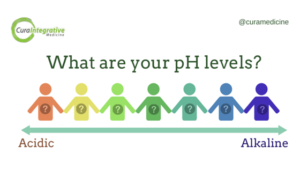 These days, talk to any alternative therapist or naturopath about chronic illness and cancer and they will have heard about the pH balance theory. It doesn’t take much internet searching to find mixed reviews and the skeptics mentioning that the body naturally balances the pH. In truth the body does balance the pH daily and is constantly doing so, but we can help it make its job much easier!
These days, talk to any alternative therapist or naturopath about chronic illness and cancer and they will have heard about the pH balance theory. It doesn’t take much internet searching to find mixed reviews and the skeptics mentioning that the body naturally balances the pH. In truth the body does balance the pH daily and is constantly doing so, but we can help it make its job much easier!
Having a balanced internal pH is essential to a person’s wellbeing. If a person’s pH levels are lower or higher than the ideal levels, then it is likely to fall ill, depending on the affected part of the body. The lungs and kidneys are primarily responsible for regulating any changes in these pH levels, offering buffers that are naturally found in body fluids. They are the first line of defense whenever there is an excess in the acidity or alkalinity. Often the first signs of tissue stress are present in kidney function and the respiratory system.
What is the Ideal pH Anyway?
The optimal pH levels vary depending on the function and composition of the fluid, or tissue, and also the enzymes that surrounds that area of the body. For example, gastric juices have a pH range of 2.0 to 3.0, which allows it to enable protein denaturation through pepsin activity. Bile and pancreatic fluid has high alkalinity, at 8.8 pH. This is to neutralize the stomach acid, aiding digestion. And, vaginal fluid has pH levels of 4.0 to 4.5 pH. Its high acidity protects the area against microbial growth. As you can see, it varies a lot and the body is constantly trying to establish balance.
In the event that the hydrogen ions – the pH levels – increase drastically, the body will no longer be able to maintain balance. This will result to chronic metabolic acidosis, an issue that is becoming more and more prevalent, such as in diabetic ketoacidosis.
The most common contributors to prolonged acidosis are poor diet, reduced kidney and/or respiratory function. Chronic acidosis is mostly linked to diabetes, metabolic syndrome, endocrine alterations, and muscle wasting.
Short-term acute acidosis may occur during fasting, infections, strenuous workouts, diarrhea, and inflammation. It naturally happens as we age too, so no one is immune to these changes in pH. It is extremely important that the underlying causes are addressed.
Do you need help with navigating through your cancer journey? Get in touch.
More on the body’s pH:
pH And Optimal Health (Part 2 of 4): Skeletal System
pH And Health (Part 3 of 4): Renal System
pH And Health (Part 4 of 4): Alkaline and Acid Foods Supplement Essentials
